What Is a VCU That Monitors and Controls Vehicle?
- Core unit that controls various pieces of equipment, based on external signals -
2023-11-22
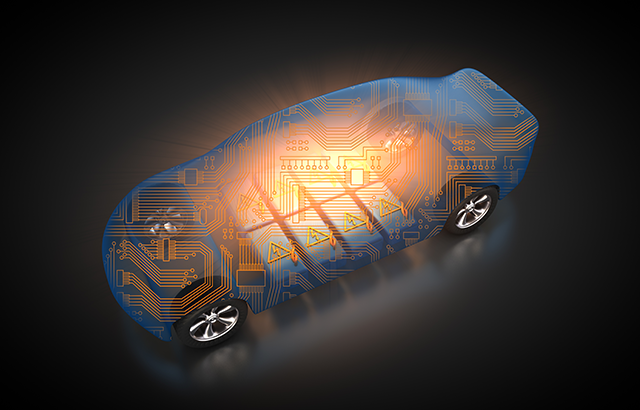
A VCU is one of the control units of a vehicle. It monitors and controls the operations and functions of the vehicle. Specifically, the VCU integrally controls electronic systems and components incorporated in the vehicle, and issues proper instructions, based on input from the driver or other ECUs. This article will discuss the functions and system configuration of the VCU and will introduce the electronic components making up the VCU as well.
1. What is a VCU?
1-1. Brief description of the VCU
A vehicle control unit (VCU) is one of the control units included in a vehicle, playing a core role among these control units. It performs centralized control over power devices, drivers, body units, etc. Specifically, the VCU issues operation instructions on various pieces of equipment, based on signals from various sensors. In-vehicle ECUs include domain-type ECUs and zone-type ECUs. A domain controller is a domain-type ECU that is equivalent to the VCU, and a Zone-ECU is a zone-type ECU that is equivalent to the VCU. These ECUs are in operation in key areas of the vehicle, respectively.
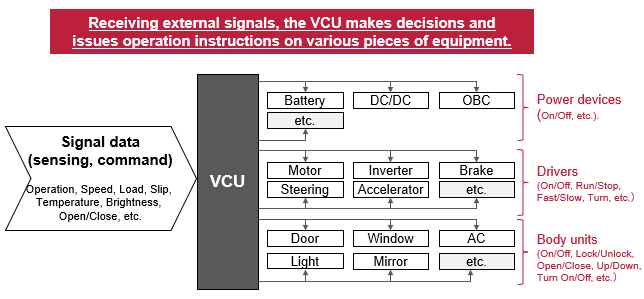
2. Trends in the market and demand for the inverter
Most autonomous driving vehicles currently produced have autonomous driving levels remaining at level 2 or lower. It is expected, however, that vehicles having level 3 autonomous driving functions will increase in the future. It is also expected that an improvement in the autonomous driving level will result in the addition of higher functions and consequently lead to an increase in the number of VCUs that collectively control equipment.
In addition, as power-operated equipment related to the vehicle's traveling function increases, more and more equipment will be put under the ECU's control. The resulting integrated control and high functions, however, create these issues: "increasing processes," "increasing power consumption," and "a higher communication rate." Electronic components making up the VCU too need to clear these issues.
3. Circuit configuration of the VCU
3-1. Overall configuration
- Transceiver:A device or a circuit that communicates with external equipment
- SoC, MCU (microcomputer):Processes data, makes a decision, and controls equipment
- Memory (DDR):Serves as a buffer when data is processed
- DC/DC converter:Converts a voltage from the battery into the different levels of voltages each electronic component or circuit needs
- Motor drive:Drives an external actuator, such as a small motor and a solenoid

4. Individual circuits and components
4-1. DC/DC converter
The DC/DC converter is composed mainly of an FET, a coil, and capacitors. In the DC/DC converter generally, a conductive polymer hybrid aluminum electrolytic capacitor is used to eliminate noise at the input end and smooth voltage output at the output end, an in-vehicle power inductor is used for voltage conversion, and a chip resistor (high-precision chip resistor) is used for voltage measurement.
Noise elimination, switching, and smoothing: Conductive polymer hybrid aluminum electrolytic capacitor
POINT- ❶ The capacitor offers high capacitance, low ESR, and high ripple-suppression performance, thus contributing to a reduction in the size of the circuit and an increase in the power capacity (low voltage and large current) of the circuit.
- ❷ Having capacitance characteristics to cut off high-frequency components, the capacitor eliminates a wide range of high-frequency noises that are generated by the high-frequency switching of the circuit.
Voltage conversion: Power Inductors for Automotive application
POINT- ❶ The inductor made of a metal magnetic material suffers less power loss and carries a large current, thus contributing to a reduction in the size of the circuit and an increase in the power capacity (low voltage and large current) of the circuit.
- ❷ Having loss characteristics in a higher frequency range (low ACR), the inductor contributes to the suppression of power loss caused by high-frequency switching of the circuit.
Voltage measurement: Chip resistor (high-precision chip resistor)
POINT- ❶ The chip resistor with a thin-film structure offers a small resistance tolerance and a low TCR, thus contributing to high-precision control of the output characteristics of the circuit.
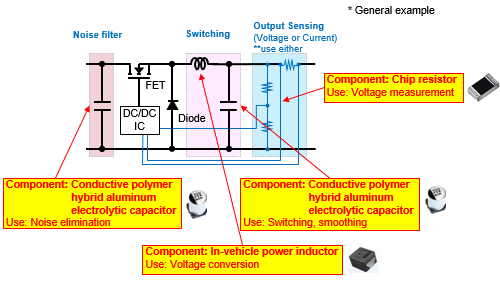
4-2. Transceiver I/F
The transceiver I/F communicates with external equipment (CAN, Ethernet, etc.) through two communication lines. If noise or static electricity enters these communication lines, it may cause a transceiver IC to fail. To prevent such problems, the transceiver IC is usually provided with combinations of chip varistors and ESD suppressors that serve as electrostatic control measures.
Electrostatic control : Chip varistor,ESD suppressor
POINT- ❶ With a wide range of capacitance characteristics, the chip varistor suppresses electrostatic discharge (ESD) noise while keeping the communication quality of the circuit intact.
- ❷ With its capacitance ranging from 8 pF to 250 pF, the chip varistor operates effectively at low to high communication speeds.
- ❸ The ESD suppressor having a capacitance of 0.1 pF operates effectively at high communication speed.
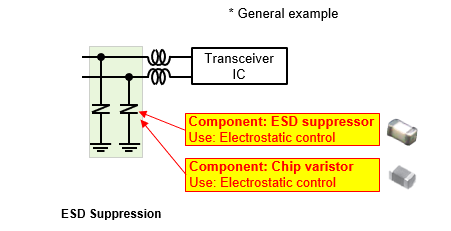
4-3. Motor drive
The motor drive circuit converts voltage by switching elements. The switching elements' switching actions cause input voltage to fluctuate, thus creating noise. To filter out this noise, a noise filter composed of a coil and a capacitor is provided. The switching elements switch on and off to make voltage conversion, but these switching actions create noise. To suppress this noise, gate terminals of these switching elements are made up of resistors.
Noise elimination and smoothing: Conductive polymer hybrid aluminum electrolytic capacitor
POINT- ❶ The capacitor offers high capacitance, low ESR, and high ripple-suppression performance, thus contributing to a reduction in the size of the circuit and an increase in the power capacity (low voltage and large current) of the circuit.
- ❷ Having capacitance characteristics to cut off high-frequency components, the capacitor eliminates a wide range of high-frequency noises that are generated by the high-frequency switching of the circuit.
Noise elimination and smoothing: Power Inductors for Automotive application
POINT- ❶ The inductor made of a metal magnetic material suffers less power loss and carries a large current, thus contributing to a reduction in the size of the circuit and an increase in the power capacity (low voltage and large current) of the circuit.
- ❷ Having loss characteristics in a higher frequency range (low ACR), the inductor contributes to the suppression of power loss caused by high-frequency switching of the circuit.
Suppressing gate-driving noise from the switching elements: Chip resistor (small and high-power chip resistor)
POINT- ❶ With its original resistance pattern, electrode structure, etc., the chip resistor is small in size and yet handles high-power operations, thus contributing to a reduction in the size of the circuit.
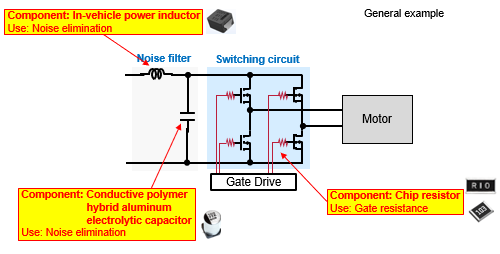
5. Summary
The VCU issues operation instructions to various pieces of equipment (power devices, drivers, body units, etc.), based on incoming signals. An improvement in the autonomous driving level will result in additional higher functions, and therefore the number of in-vehicle VCUs is expected to increase. In addition, as the number of power-operated equipment related to the vehicle's traveling function increases, more and more equipment will be put under the ECU's control. The resulting integrated control and high functions, however, create these issues: "increasing processes," "increasing power consumption," and "higher communication rate." To deal with these issues, the electronic components making up the VCU are required to have these essential properties: "high power," "low loss," "small size," "high frequency," and "high precision (voltage control)." Panasonic Industry offers a wide variety of products for use in the VCU (Table 1).
| Component | Feature | Large current | Low loss | Miniaturization (small size) | High frequency | High precision |
|---|---|---|---|---|---|---|
Conductive polymer hybrid aluminum electrolytic capacitor |
Low ESR High reliability |
✔ | ✔ | ✔ | ✔ | |
Power Inductors for Automotive application  |
Large current, low loss High reliability |
✔ | ✔ | ✔ | ✔ | |
 |
High precision, high resistance to heat |
✔ | ✔ | ✔ | ||
Chip varistor |
Small and light | ✔ | ||||
ESD suppressor |
Low capacitance Ultrafast data I/F |
✔ | ✔ |
6. Related product information
7. Related information
- Automotive Trend into the “CASE” Era and Technology Issues (1)- 48-V System Mild Hybrid -
- Automotive Trend into the “CASE” Era and Technology Issues (2)- Battery Management System -
- Automotive Trend into the “CASE” Era and Technology Issues (3) - Automated Driving and Recognition Engine
- What is a Domain Control Unit (DCU) used in autonomous driving technology?- Group of devices that contribute to higher performance -
